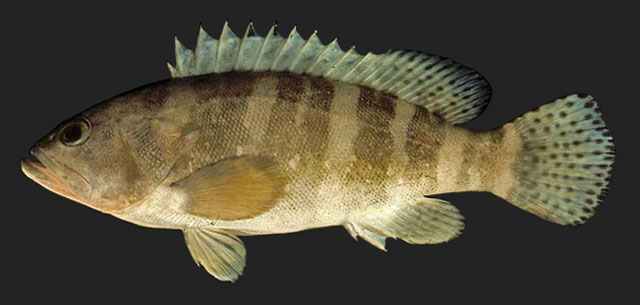| Epinephelidae (Groupers) |
| 40 cm TL (male/unsexed) |
|
reef-associated; marine; depth range 10 - 80 m |
| Western Central Pacific: known only from tropical waters, from Thailand and the Philippines to northern Australia. |
|
Dorsal spines (total): 11-11; Dorsal soft rays (total): 14-16; Anal spines: 3-3; Anal soft rays: 8-8. Preopercle with two to four greatly enlarged serrae at its angle; upper edge of the operculum straight; nostril sub equal. Maxilla reaches to or slightly past the vertical a rear edge of the eye. Pectoral fins not fleshy. Pyloric caeca 7 or 8. Color of head and body pale grayish brown with 5 dark brown bars on the body and 1 on nape. Scattered pale spots may be present on body and some faint small brown spots are often on the edges of the dark bars. The soft dorsal, caudal, and pelvic fins dusky gray, the pectoral fins grayish or orange-red. The jaws and ventral parts of the head sometimes pale reddish brown. |
| Common on silty sand or mud bottoms. Its preference for soft-bottom habitats may account for its restricted distribution and absence at oceanic islands. Feeds on small fishes and crustaceans (Ref. 89707). |
|
Least Concern (LC); Date assessed: 12 March 2018 Ref. (130435)
|
| harmless |
Source and more info: www.fishbase.org. For personal, classroom, and other internal use only. Not for publication.
